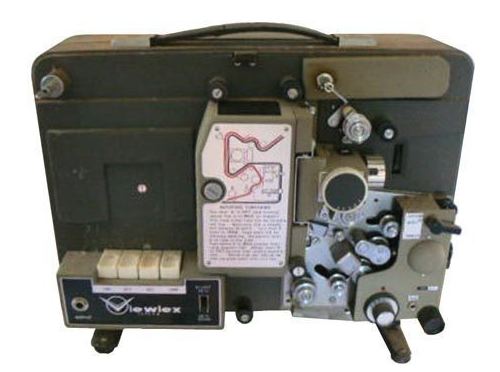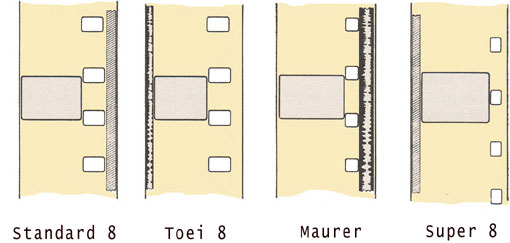This is topic Optical sound was first in forum 8mm Forum at 8mm Forum.
To visit this topic, use this URL:
https://8mmforum.film-tech.com/cgi-bin/ubb/ultimatebb.cgi?ubb=get_topic;f=1;t=007127
Posted by Dino Everette (Member # 1378) on May 24, 2012, 11:15 PM:
I never knew this but I was flipping through an old Film World magazine from march 1966 and ran across this news item. They are calling it 8mm but they mean super 8, and this means that the optical sound was quite a few years before the magnetic..I just never knew that before.

Posted by Akshay Nanjangud (Member # 2828) on May 25, 2012, 12:24 AM:
So optical sound was the first on Super 8. What about other film formats?
Posted by Maurice Leakey (Member # 916) on May 25, 2012, 02:56 AM:
The SMPE proposed 16mm optical sound (using the RCA system) in 1932 and this was adopted by the American manufacturers. However, in Europe the DIN system remained for a few years until it too, accepted the SMPE standard.
DIN projectors had their optical tracks on the opposite side, i.e. the 16mm sound track was towards the operator.
Pathe's 'Super Rural' introduced optical sound on 17.5mm in 1934, and later, in 1937 their 'Vox' had optical sound on 9.5mm.
Posted by Alwyn Jones (Member # 3062) on May 25, 2012, 05:51 AM:
I'm sure they do mean Super 8, but on standard 8 optical sound - the "Toei Talkie" OPTICAL/magnetic projector was available in about 1963 here in the UK, only through Dixons photographic shops.
Never went for one though, as 8mm optical never seemed to get off the ground, well at that time anyhow. Never seen one for sale, nor ever seen or heard a Standard 8 optical print.
Not much to do with the cutting displayed above I know, but I thought I'd point out the first appearance of Standard 8 optical this side of the pond to my knowledge.
See here http://www.cinerdistan.co.uk/Pictures2/Toei0001.jpg
Posted by Allan Broadfield (Member # 2298) on May 25, 2012, 07:12 AM:
The Toei optical--mag standard eight projector was my first sound machine, though never had the chance to try optical as I imagine it was only available in Japan. Standard eight optical films had a much reduced picture image as the optical track took a lot more space than magnetic sound. Projection was achieved by an adjustable gate apperture. Machine operated mag sound very well, though the mechinism was rather noisy.
Posted by Dino Everette (Member # 1378) on May 25, 2012, 11:16 AM:
Some good info guys...I was just surprised that given the drawbacks of the standard 8 optical, that they would have gone straight into it with the Super8 almost as soon as it was launched...
Posted by Osi Osgood (Member # 424) on May 25, 2012, 01:10 PM:
Interesting ... though I have set, (as close to accurate as I could be) the first optical sound super 8 features in 1967, they could have started in 66.
Very interesting Dino and many thanx! There is so much info about optical sound films that to this day, we don't know and perhaps, will never know. By the way, I have a few of these educational style super 8 opticals, and I have always assumed (due to the subject matter, style and look) that they were late 60's or early 70, they could, perhaps, be a little earlier.
Posted by Hugh Thompson Scott (Member # 2922) on May 25, 2012, 01:31 PM:
Well chaps have you forgotten so soon,Tommy Woods has a
lovely little Toei Talkie projector that was available through
Dixons Photographic in the '60s.Then there was the prototype
Format M in Italy that used the bigger frame area and smaller
std 8 sprocket holes & opt snd.This was at the same time as the
s/8 gauge was introduced.So std 8 was the first with opt snd.
Posted by Joe Taffis (Member # 4) on May 25, 2012, 04:01 PM:
Would this be the reason some of the earlier Elmo ST1200s have Optical and Magnetic capability?
Posted by Hugh Thompson Scott (Member # 2922) on May 25, 2012, 04:54 PM:
Well I remember when the Elmo ST1200 came out '75 It was when I first got one and Derann had some optical releases as did
Tony Powell in conjunction with their magnetic ones, I think the
distributors were testing the waters to see if opt was going to fly
and unfortunately it didn't, as response wasn't to great and mag
was still the norm.Although those collectors that had invested
in mag/opt machines were rewarded when the ex airline prints
started appearing,although by that time I think it was too late.
Posted by Kenneth Horan (Member # 3) on May 25, 2012, 07:51 PM:
Here is a picture of the Viewlex 'Mauer-8' projector mentioned in the article.


Posted by Dino Everette (Member # 1378) on May 25, 2012, 10:44 PM:
Ken, thanks for the pic, If I am getting this correct it almost looks like a non standard format? Was this exclusive to this projector and releases, with the sound track on the outside of the sprockets?
Posted by Kenneth Horan (Member # 3) on May 26, 2012, 12:48 AM:
Hey Dino, The Viewlex projector would run 'Mauer-8' optical as well as standard 8 magnetic sound films. The sprockets would fit both formats. 'Mauer-8' was a non-standard format that never caught on. Although Fumeo and Micron also made machines for 'Mauer-8'.
Posted by Joe Taffis (Member # 4) on May 26, 2012, 07:58 AM:
I remember seeing this machine in a different thread somewhere recently here on the Forum. It was being linked from an eBay auction.
Posted by Hugh Thompson Scott (Member # 2922) on May 26, 2012, 09:23 AM:
Well that's the picture sorted out,now for the sound separation!!!!
Posted by Osi Osgood (Member # 424) on May 26, 2012, 12:21 PM:
I would assume that standard 8mm optical sound would been even weaker , in general, than super 8 optical sound, with the track being that much smaller.
That's always been a problem with optical sound. Though it can sound quite good, (they really perfected super 8 optical sound in the 80's with big booming optical tracks), however, alas, the smaller the track, the more dust and debris can affect the overall sound, giving the soundtrack at times, way too much pop and hiss, epscially the more faded and weaker the optical track becomes, due to fading, as the sust and debris stays the same volume!
Anyone who knows me knows that i just LOVE optical sound super 8 (now over than 60 optical sound super 8 features!) and finding out any new information is just awesome for me!
Posted by Allan Broadfield (Member # 2298) on May 26, 2012, 07:03 PM:
Excellent pics, I've never actually seen standard 8 optical film, I assumed the track was larger due to the gate adjustment on the Toei. I can't think why mag. took preference, it has wider frequency response but optical is quicker and cheaper to produce.
Posted by Bill Brandenstein (Member # 892) on May 27, 2012, 01:09 AM:
Osi, do you ever try to determine the date of origin of your prints? (Done by using a loupe or other magnifier and looking for date codes on the edge, often partially cut off by sprocket holes, so you have to look at several.) Fuji and Eastman prints are usually pretty date-able.
Posted by Osi Osgood (Member # 424) on May 28, 2012, 12:54 PM:
Actually, unless the optical soundsuper 8 is a reprint of a classic, (African Queen, Stagecoach, for instance), nearly all the optical features were released as of the time that they were originally released to the mopvie theaters, or within a limited time after that ...
Therefore, my copy of the Lee marvin classic "Point Blank" was either 1968 or shortlythereafter. The date codes on the Eastman prints are fairly unrelaible, as I have seen everything from "stock 14" to "stock 21" (21 has tended to hold up better, by the way) ranging for a period of at least 10 years!
By the way, the quality of the optical releases varied widely due to the studio of origin.
While MGM would re-release they're "Pete Smith Specialties" (shorts) from the 40's or 50's with thier optical sound features, (a nice touch!), the print quality of the short would be pin sharp, (no doubt from vinate 35MM studio prints) while the feature that would follow, would be taken from what looked like a 16Mm TV print, and that MGM feature prints would vary widely on the sharpness of the image.
Another curiosity is that, depending on the studio of origin, the film stock could range widely. nearly all my vintage MGM's have varying degrees of fade, (Though "Point Blank", curiously, has better color than some of the mid 70's MGM prints) ...
... I have "Film Cinema Center" super 8 optical prints, two of them, and the color has not faded a bit, they really re a joy to screen! They are both "PEANUTS" animated features ...
A Boy Named Charlie Brown (1969)
Snoopy Come Home (1971 or 72, based upon different film guides) ... both prints being over 40 years old and still pristine ...
and before anyone asks, yes, I have scrutinized thesed two print with a fine toothed comb (and little lense!) and they at least, do not say "Technicolor" on them anywhere, bu the color is perfect!
So, the "Film Cinema Center" studio made sure to use dlabs and printing facilities than MGM, and it certainly shows!
Posted by Bill Brandenstein (Member # 892) on May 28, 2012, 07:37 PM:
Yes, but Technicolor don't ever say that they are unless it's on the leader -- and then, most of the time, it's NOT! That's because it was always receiver film by Eastman, a B/W stock. So they well could be, Osi!
I'm less familiar with terms like "Stock 14" or "Stock 21," rather dating films by the Eastman date codes, which are a 2 or 3 "digit" combination of squares, circles, triangles, and plusses. Osi, do your early optical films have any such markings?
Posted by Hugh Thompson Scott (Member # 2922) on May 29, 2012, 02:26 PM:
I did read somewhere that during part of the processing of opt.
snd prints,the track was covered up in the American Labs which
gave very good sound,but wasn't in the prints produced in the
UK ,which resulted in low volume soundtracks.
Posted by Osi Osgood (Member # 424) on May 31, 2012, 01:28 PM:
Your right Hugh!
The UK prints do tend to have lesser sound. From what I remember, there was some sort of coating added to the optical soundtrack that allowed for them to have a boast to thier sound, as well as not having the tendecy to fade.
To answer the other question, nearly all the print I have, (except for those two "Peanuts" films), have eastman numbers or symbols on them. Occasionally, as In the "Peanuts" prints, there are no markings whatsoever, and most of those prints, especially releases after the mid 70's, I think, are Fuji stock, but that is only an educated guess.
Posted by Kenneth Horan (Member # 3) on June 01, 2012, 09:18 PM:
Hi All, The coating over a dye optical track on a color print is silver. The light beam from a standard exciter is then able to read the track as if it were a black & white print, which is a silver track. FYI, IB (dye-transfer) Technicolor is printed on B&W stock and by default is a silver track.
Visit www.film-tech.com for free equipment manual downloads. Copyright 2003-2019 Film-Tech Cinema Systems LLC

UBB.classicTM
6.3.1.2


